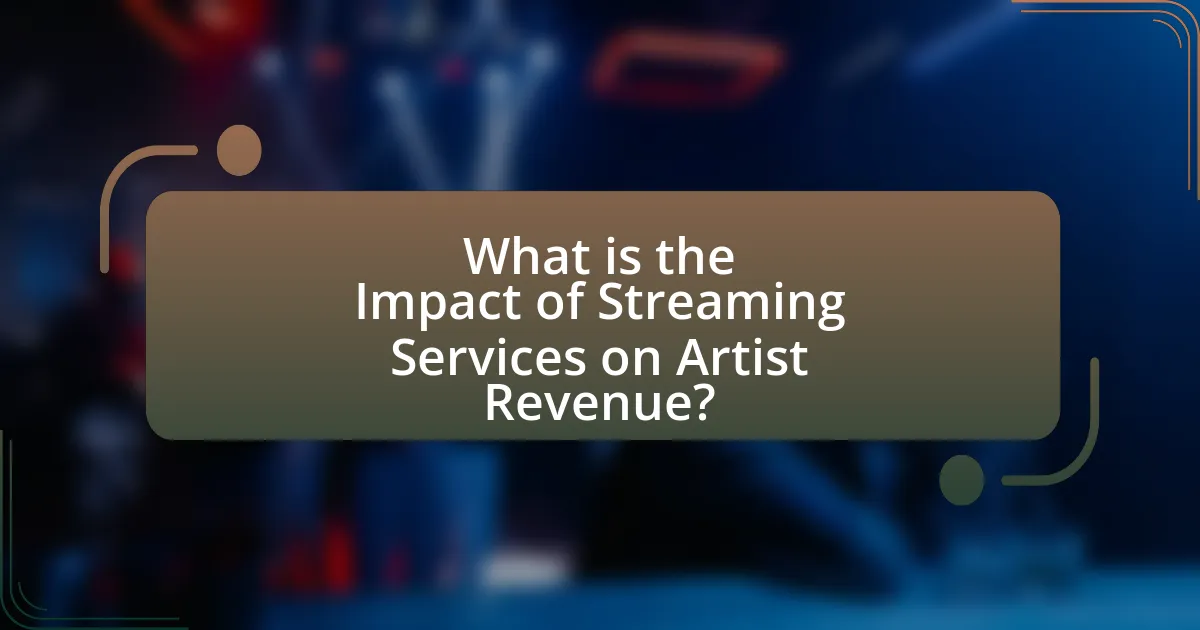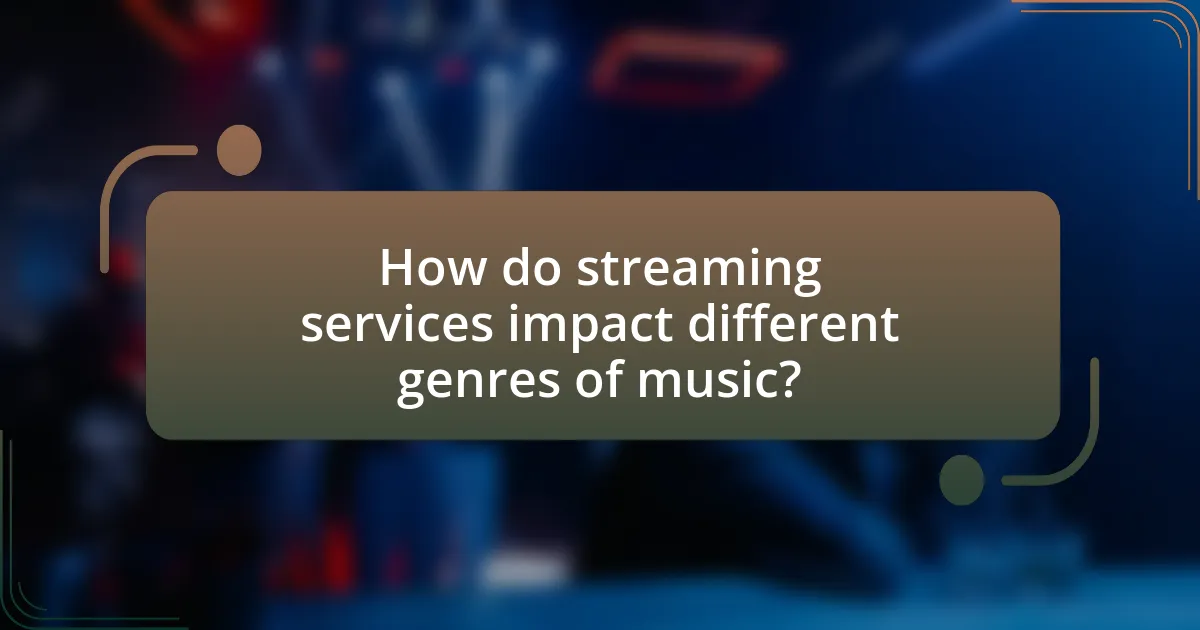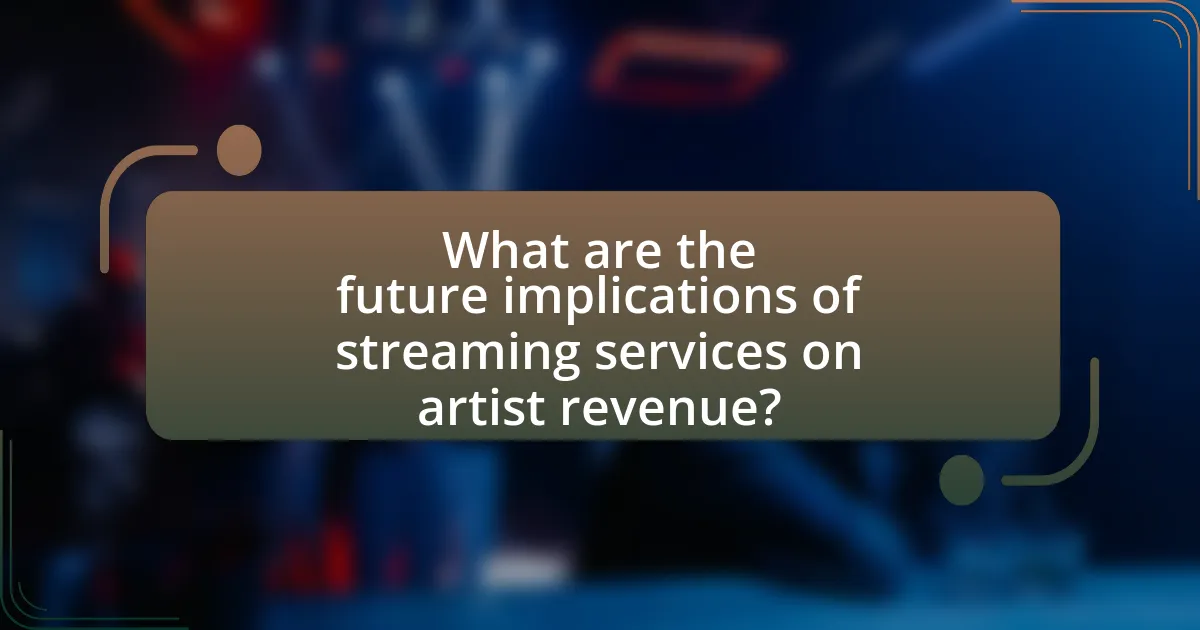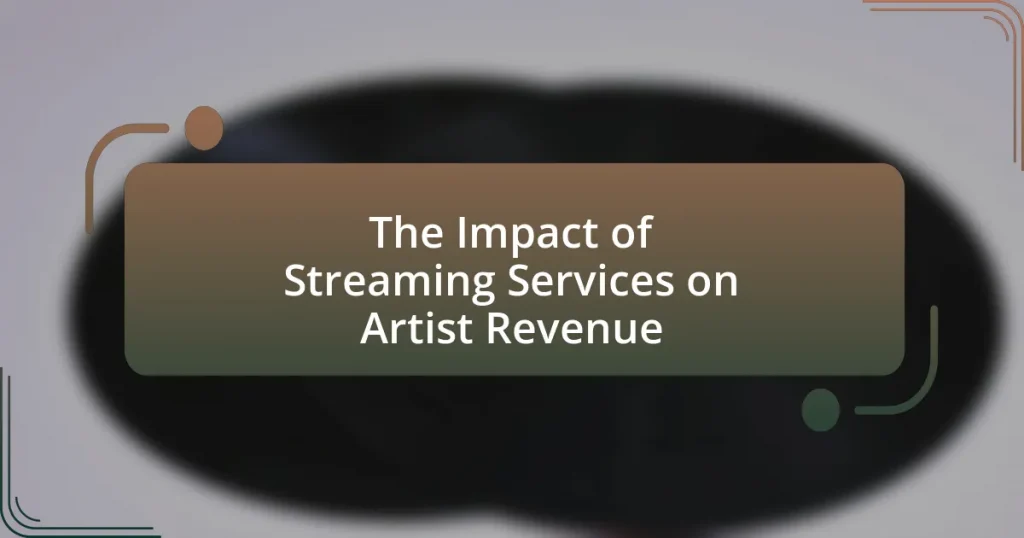The article examines the impact of streaming services on artist revenue, highlighting the significant reduction in income per stream compared to traditional sales. It discusses how the shift to subscription-based models has transformed the music industry, leading to increased accessibility but also raising concerns about fair compensation for artists. Key features influencing artist revenue, such as payout structures and licensing agreements, are analyzed, along with the challenges faced by independent artists in a landscape dominated by major labels. The article also explores the implications of streaming on different music genres, demographic influences on revenue, and strategies artists can adopt to maximize their earnings in the streaming era.

What is the Impact of Streaming Services on Artist Revenue?
Streaming services have significantly altered artist revenue, primarily by reducing the income artists earn per stream compared to traditional sales. For instance, in 2020, the average payout per stream on platforms like Spotify was estimated to be between $0.003 and $0.005, which is substantially lower than the revenue generated from physical album sales or digital downloads. This shift has led to a reliance on touring and merchandise sales for many artists, as streaming alone often does not provide sustainable income. Additionally, the dominance of a few major platforms has created a competitive landscape where only a small percentage of artists receive the majority of streaming revenue, further exacerbating income inequality within the music industry.
How have streaming services changed the music industry landscape?
Streaming services have fundamentally transformed the music industry landscape by shifting revenue models from physical sales and downloads to subscription-based streaming. This transition has resulted in a significant increase in music accessibility, allowing listeners to access vast libraries of music for a monthly fee, which has led to a dramatic rise in the number of songs streamed. For instance, in 2020, the Recording Industry Association of America reported that streaming accounted for 83% of the total music industry revenue in the United States, highlighting the dominance of this model. Additionally, while streaming has expanded audience reach, it has also raised concerns regarding artist compensation, as many artists receive only a fraction of a cent per stream, prompting discussions about fair pay and revenue distribution within the industry.
What are the key features of streaming services that influence artist revenue?
The key features of streaming services that influence artist revenue include payout structures, user engagement metrics, and licensing agreements. Payout structures determine how much artists earn per stream, which varies significantly across platforms; for instance, Spotify pays approximately $0.003 to $0.005 per stream, while Apple Music offers around $0.007 to $0.01 per stream. User engagement metrics, such as the number of active listeners and playlist placements, directly affect an artist’s visibility and potential earnings. Additionally, licensing agreements dictate how royalties are distributed, impacting the overall revenue artists receive from their music. These features collectively shape the financial landscape for artists in the streaming era.
How do streaming platforms differ from traditional music distribution methods?
Streaming platforms differ from traditional music distribution methods primarily in their delivery model and revenue structure. Streaming services provide on-demand access to a vast library of music for a subscription fee or ad-supported model, allowing users to listen to any song at any time without owning it. In contrast, traditional distribution methods, such as physical sales (CDs, vinyl) and digital downloads, require consumers to purchase individual tracks or albums, resulting in a one-time transaction.
The revenue generated by streaming platforms is typically shared among multiple stakeholders, including record labels, artists, and songwriters, based on the number of streams, which can lead to lower per-stream payouts for artists compared to the upfront payments from traditional sales. For example, in 2020, the average payout per stream on platforms like Spotify was estimated to be between $0.003 and $0.005, significantly less than the revenue artists would receive from selling a physical album for $10 or more. This shift in distribution has fundamentally altered how artists earn revenue, often leading to a reliance on touring and merchandise sales to supplement income.
Why is understanding artist revenue important in the context of streaming?
Understanding artist revenue is crucial in the context of streaming because it directly influences the sustainability of artists’ careers. Streaming platforms have transformed music consumption, yet they often provide lower per-stream payouts compared to traditional sales, which can significantly impact an artist’s income. For instance, a report by the Music Industry Revenue Report 2022 indicated that the average payout per stream is approximately $0.004, meaning an artist would need millions of streams to earn a living wage. This financial reality underscores the importance of artists comprehending their revenue streams to navigate the evolving landscape effectively and advocate for fair compensation.
What are the primary revenue streams for artists in the streaming era?
The primary revenue streams for artists in the streaming era include streaming royalties, merchandise sales, live performances, and licensing deals. Streaming royalties, which artists earn from platforms like Spotify and Apple Music, account for a significant portion of their income, with the average payout per stream being approximately $0.003 to $0.005. Merchandise sales have become increasingly important as artists leverage their online presence to sell branded products directly to fans. Live performances generate substantial revenue, especially as artists tour to promote their music, with the global live music market valued at over $25 billion in 2022. Additionally, licensing deals for music used in commercials, films, and television provide artists with another vital income source, often yielding higher payouts than streaming royalties alone.
How does streaming revenue compare to physical sales and downloads?
Streaming revenue significantly surpasses physical sales and downloads in the current music industry landscape. In 2022, streaming accounted for approximately 83% of the total music revenue in the United States, while physical sales and downloads contributed only about 10% and 7%, respectively. This shift is largely due to the convenience and accessibility of streaming platforms, which have become the primary method for music consumption. For instance, the Recording Industry Association of America (RIAA) reported that streaming generated $10.4 billion in revenue, compared to $1.5 billion from physical sales and $1.1 billion from downloads. This data illustrates the dominant role of streaming in artist revenue generation today.
What challenges do artists face with streaming services?
Artists face significant challenges with streaming services, primarily related to low revenue per stream. For instance, platforms like Spotify pay artists an average of $0.003 to $0.005 per stream, which means that artists need millions of streams to earn a sustainable income. Additionally, the lack of transparency in how streaming royalties are calculated complicates financial planning for artists. Many artists also struggle with the dominance of major labels on these platforms, which can limit exposure for independent musicians. Furthermore, the reliance on playlists for visibility creates pressure to conform to popular trends, potentially stifling artistic expression. These factors collectively hinder artists’ ability to monetize their work effectively in the streaming landscape.
How do streaming payouts affect independent versus signed artists?
Streaming payouts significantly favor signed artists over independent artists due to the established contracts and promotional support that signed artists receive from record labels. Signed artists typically benefit from higher payout rates and better access to marketing resources, which can lead to increased streams and revenue. For instance, a report by the Digital Media Association indicates that major labels negotiate better terms with streaming platforms, resulting in higher per-stream payouts compared to the rates independent artists receive. Additionally, independent artists often face challenges in gaining visibility on streaming platforms, which can limit their overall earnings despite having the same access to the platforms. This disparity highlights the financial advantages that signed artists have in the streaming economy.
What role do contracts and agreements play in artist revenue from streaming?
Contracts and agreements are crucial in determining how artists earn revenue from streaming services. These legal documents outline the terms of compensation, including royalty rates, distribution percentages, and rights to the music. For instance, a standard contract may stipulate that an artist receives a specific percentage of the revenue generated from streams, which can vary significantly between different streaming platforms. According to a 2021 report by the Music Industry Research Association, artists typically earn between $0.003 and $0.005 per stream, highlighting the importance of negotiating favorable terms in contracts to maximize earnings. Additionally, agreements can dictate how revenue is split among collaborators, producers, and record labels, further impacting the artist’s overall income. Thus, the structure and specifics of contracts directly influence the financial outcomes for artists in the streaming landscape.

How do streaming services impact different genres of music?
Streaming services significantly influence various music genres by altering how listeners access and consume music. For instance, pop and hip-hop genres have seen substantial growth in streaming numbers, with platforms like Spotify and Apple Music providing extensive playlists and algorithm-driven recommendations that promote these genres. According to a report by the Recording Industry Association of America (RIAA), streaming accounted for 83% of the U.S. music industry’s revenue in 2020, highlighting the dominance of these genres in the streaming landscape. Conversely, niche genres such as classical or jazz often struggle to gain similar traction, as their audiences are typically smaller and less engaged with streaming platforms. This disparity in genre popularity can lead to unequal revenue distribution, with mainstream genres benefiting more from the streaming model compared to less popular ones.
Which genres benefit the most from streaming services?
Pop, hip-hop, and electronic dance music (EDM) are the genres that benefit the most from streaming services. These genres have high streaming numbers due to their broad appeal and the ability to reach younger audiences who predominantly consume music through platforms like Spotify and Apple Music. For instance, in 2020, hip-hop accounted for 28.2% of all on-demand audio streams in the U.S., while pop music followed closely with 25.5%, demonstrating their dominance in the streaming landscape. This trend indicates that artists in these genres can generate significant revenue through streaming, as they attract large listener bases and frequent playlist placements, which enhance their visibility and earnings.
How does streaming affect the visibility of niche genres?
Streaming significantly enhances the visibility of niche genres by providing a platform where diverse musical styles can reach broader audiences. Unlike traditional media, which often favors mainstream content, streaming services utilize algorithms that recommend niche genres to users based on their listening habits, thereby increasing exposure. For instance, Spotify’s Discover Weekly feature has been shown to boost streams for less popular genres, with reports indicating that independent artists in niche categories experience a 30% increase in visibility after being featured in curated playlists. This democratization of music distribution allows niche genres to thrive, as they can now find dedicated listeners who may not have encountered them through conventional channels.
What trends can be observed in genre-specific streaming revenue?
Genre-specific streaming revenue shows a significant trend towards increased earnings for genres like hip-hop and pop, while genres such as classical and jazz experience slower growth. According to the Recording Industry Association of America (RIAA), hip-hop accounted for 28.2% of total music revenue in 2020, reflecting its dominance in streaming platforms. Additionally, pop music continues to thrive, with major artists consistently topping streaming charts, indicating a strong listener base. In contrast, classical music, despite its niche audience, has seen only modest revenue increases, highlighting a disparity in streaming engagement across genres. This trend underscores the varying impacts of streaming services on artist revenue, influenced by listener preferences and market dynamics.
How do demographics influence streaming revenue for artists?
Demographics significantly influence streaming revenue for artists by determining audience size, engagement levels, and spending habits. For instance, younger demographics, particularly those aged 18-34, are more likely to use streaming services, contributing to higher revenue through subscriptions and ad-supported models. According to a 2021 report by the Recording Industry Association of America (RIAA), this age group accounted for over 50% of total streaming consumption, highlighting their critical role in revenue generation. Additionally, geographic demographics affect revenue, as regions with higher disposable incomes tend to have more subscribers to premium streaming services, further enhancing artists’ earnings.
What age groups are most likely to use streaming services?
Individuals aged 18 to 34 are the most likely to use streaming services. According to a 2021 report by the Pew Research Center, 71% of adults in this age group subscribe to at least one streaming service, significantly higher than older demographics. Additionally, the 35 to 54 age group follows, with about 58% using streaming platforms, while only 38% of those aged 55 and older engage with these services. This data highlights the strong preference for streaming among younger audiences, which influences the overall landscape of media consumption and artist revenue.
How do geographic locations affect streaming revenue distribution?
Geographic locations significantly affect streaming revenue distribution by influencing market size, consumer purchasing power, and local licensing agreements. For instance, streaming services generate higher revenues in regions with larger populations and higher disposable incomes, such as North America and Western Europe, compared to developing regions where access to streaming may be limited. Additionally, local licensing agreements can vary, impacting how much revenue artists receive from streams in different countries. According to a report by the International Federation of the Phonographic Industry (IFPI), markets like the United States accounted for 40% of global recorded music revenue in 2020, highlighting the disparity in revenue distribution based on geographic location.

What are the future implications of streaming services on artist revenue?
The future implications of streaming services on artist revenue indicate a continued decline in per-stream payouts, which may lead to reduced income for many artists. As streaming platforms dominate music consumption, the average payout per stream remains low, with estimates suggesting that artists earn between $0.003 and $0.005 per stream. This trend is exacerbated by the increasing market share of major labels, which often negotiate more favorable terms for themselves, leaving independent artists with even less revenue. Additionally, the reliance on streaming for exposure may pressure artists to produce more content to maintain visibility, potentially diluting their artistic output.
How might changes in technology affect streaming revenue models?
Changes in technology can significantly alter streaming revenue models by introducing new monetization strategies and altering consumer behavior. For instance, advancements in artificial intelligence and machine learning enable personalized content recommendations, which can increase user engagement and subscription rates. According to a report by PwC, the global streaming market is projected to grow from $50 billion in 2020 to over $100 billion by 2025, driven in part by technological innovations that enhance user experience. Additionally, the rise of blockchain technology offers potential for more transparent revenue distribution, allowing artists to receive payments directly from consumers, thereby reducing reliance on traditional intermediaries. This shift could lead to a more equitable revenue model for artists, as evidenced by platforms like Audius, which leverage blockchain to facilitate direct artist-to-fan transactions.
What innovations are being explored to enhance artist earnings from streaming?
Innovations being explored to enhance artist earnings from streaming include blockchain technology, direct-to-fan platforms, and enhanced royalty distribution models. Blockchain technology allows for transparent tracking of music usage and ensures that artists receive fair compensation by automating royalty payments through smart contracts. Direct-to-fan platforms, such as Patreon and Bandcamp, enable artists to sell their music and merchandise directly to fans, bypassing traditional streaming services and retaining a larger share of revenue. Enhanced royalty distribution models, like those proposed by organizations such as the Music Industry Innovation Fund, aim to create more equitable payment structures that better reflect the actual consumption of music, ensuring that artists earn more from their work.
How could shifts in consumer behavior impact artist revenue in the future?
Shifts in consumer behavior could significantly impact artist revenue in the future by altering how music is consumed and monetized. As more consumers gravitate towards streaming services for music access, traditional revenue streams such as album sales and physical merchandise may decline. For instance, a report from the Recording Industry Association of America (RIAA) indicated that streaming accounted for 83% of the U.S. music industry’s revenue in 2020, highlighting a clear shift in consumer preference. Additionally, if consumers increasingly favor subscription models over purchasing individual tracks, artists may see a change in their earnings structure, relying more on royalties from streaming platforms rather than direct sales. This transition could lead to a more volatile income for artists, as streaming payouts are often lower per play compared to traditional sales, thereby affecting overall revenue stability.
What strategies can artists adopt to maximize revenue from streaming services?
Artists can maximize revenue from streaming services by diversifying their income streams, engaging with their audience, and leveraging data analytics. Diversification includes offering merchandise, live performances, and exclusive content, which can significantly enhance overall earnings. Engaging with fans through social media and direct communication fosters loyalty and encourages streaming, as artists who maintain a strong connection with their audience often see increased plays and shares. Utilizing data analytics allows artists to understand listener preferences and optimize their release strategies, leading to higher engagement rates. For instance, according to a 2021 report by the International Federation of the Phonographic Industry, artists who actively engage with their fanbase and utilize streaming data effectively can increase their revenue by up to 30%.
How can artists leverage social media to boost their streaming numbers?
Artists can leverage social media to boost their streaming numbers by actively engaging with their audience and promoting their music through targeted content. By sharing behind-the-scenes footage, personal stories, and interactive posts, artists can create a deeper connection with fans, which encourages them to stream their music. For instance, a study by the International Federation of the Phonographic Industry (IFPI) found that 70% of music listeners discover new music through social media platforms. Additionally, artists can utilize features like Instagram Stories, TikTok challenges, and live streaming to showcase new releases, driving traffic to their streaming platforms. This strategy not only increases visibility but also fosters community engagement, leading to higher streaming numbers.
What role does fan engagement play in increasing streaming revenue?
Fan engagement significantly increases streaming revenue by fostering a loyal listener base that drives subscription growth and boosts streaming numbers. Engaged fans are more likely to subscribe to streaming platforms, attend live events, and purchase merchandise, all of which contribute to higher revenue streams for artists. For instance, a study by Midia Research found that artists with strong fan engagement can see up to 50% higher streaming revenue compared to those with less engagement. This correlation highlights the importance of building a dedicated fan community, as it directly translates into increased financial support through various channels associated with streaming services.
